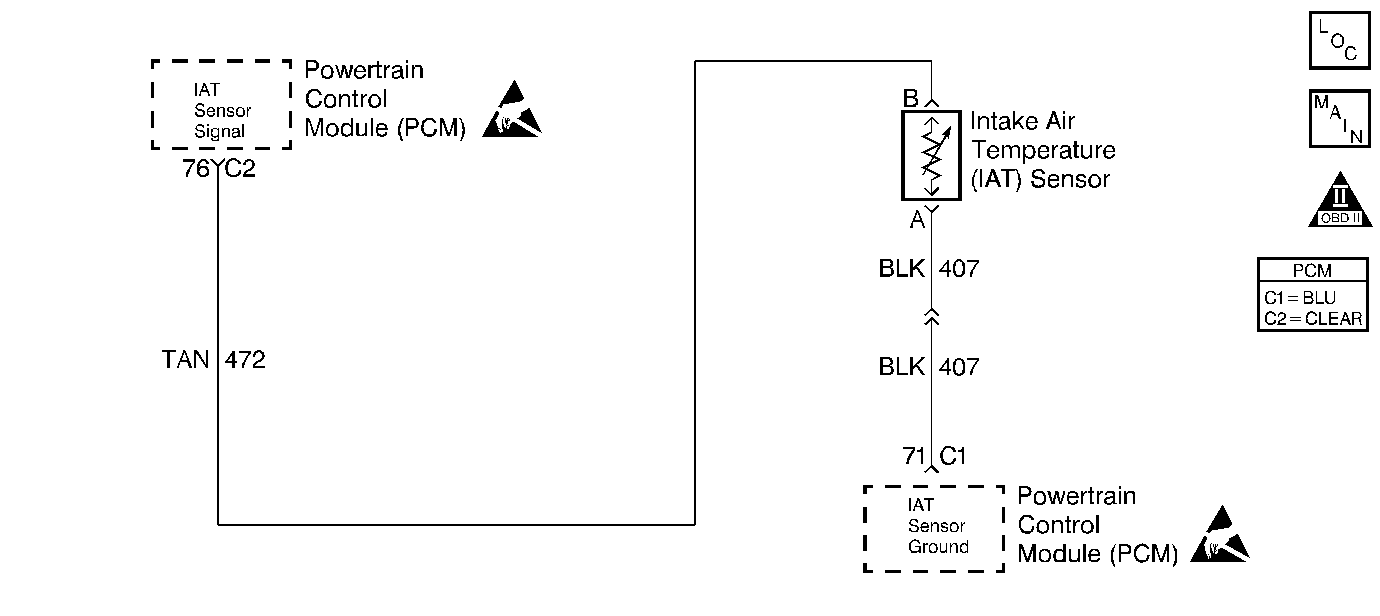
Circuit Description
The Intake Air Temperature (IAT) sensor is a thermistor, or variable resistor, that varies resistance based on temperature. Low temperature will result in a high signal voltage. If the IAT reading is -35°C (-30°F) or lower with the ECT sufficiently hotter than the IAT, the PCM sets DTC P1111.
Conditions for Running the DTC
| • | DTCs P0101, P0102, P0112, P0113, P0117, P0118, and P0502 not set. |
| • | Engine speed 500 RPM or greater for 10 seconds. |
| • | MAF input 60 grams per second or less. |
| • | Vehicle speed 50 MPH or less. |
| • | 5 seconds have passed with vehicle speed greater than 7 MPH since the engine was started. |
| • | Engine coolant temperature 0°C (32°F) or greater, or engine coolant temperature less than 0°C (32°F) and IAT at least 27°C (81°F) less than engine coolant temperature. |
Conditions for Setting the DTC
IAT -35°C (-30°F) or less with the above test conditions met.
Action Taken When the DTC Sets
| • | The Malfunction Indicator Lamp (MIL) will not illuminate. |
| • | No message will be displayed. |
Conditions for Clearing the DTC
| • | A History DTC will clear after forty consecutive warm-up cycles with no failures of any non-emission related diagnostic test. |
| • | A Last Test Failed (current) DTC will clear when the diagnostic runs and does not fail. |
| • | Use a scan tool to clear DTCs. |
| • | Interrupting PCM battery voltage may or may not clear DTCs. This practice is not recommended. Refer to Clearing Diagnostic Trouble Codes in Powertrain Control Module Description . |
Diagnostic Aids
If fault is not present perform Powertrain Ground Check and also review Failure Rec. to determine conditions under which and how long ago the DTC set.
If a faulty sensor is suspected refer to Temperature vs Resistance table.
Test Description
Number(s) below refer to the step number(s) on the Diagnostic Table.
-
If DTC P0111 is also set, diagnose it first because it may help to pinpoint a faulty IAT sensor.
-
Checking for intermittent circuit faults that may cause a high IAT reading.
Step | Action | Value(s) | Yes | No |
|---|---|---|---|---|
1 | Did you perform the Powertrain On-Board Diagnostic (OBD) System Check? | -- | Go to Step 2 | |
Turn the key ON. Is DTC P0111 or P0113 also set? | -- | Go to DTCs that are set | Go to Step 3 | |
Was terminal contact repaired? | -- | Go to Powertrain Control Module Diagnosis for Verify Repair | Go to Step 4 | |
4 |
Was terminal contact repaired? | -- | Go to Powertrain Control Module Diagnosis for Verify Repair | Go to Step 5 |
5 |
Was a repair made to any circuit? | -- | Go to Powertrain Control Module Diagnosis for Verify Repair | Fault not present. Refer to Diagnostic Aids |
